While we live in an era of Gigabit speeds, there’re still millions of people across the US struggling with very low internet speeds. Many of you would consider 5 Mbps unacceptable. But is it really? In this article, we will discuss the capabilities of 5 Mbps. You will find out what you can and cannot do with 5 Mbps, and how to get the most out of your internet plan. Let’s start with some basics.
CONTENTS
Basic Internet Terminology
We all use a bunch of internet terms every day, but do we really know what each of these terms means? Here are some clarifications.
What is Broadband Internet?
While you may think that any kind of internet is considered broadband internet and that these two terms are synonyms, the truth is somewhat different. In the US, FCC defines broadband internet as a high-speed internet transmission of wide-bandwidth data using speeds of at least 25 Mbps download and 3 Mbps upload. This definition is active since 2015 and hasn’t been updated yet. Many citizens all over the US don’t have access to the FCC-defined benchmark speeds and we will talk about that in one of the following chapters.
We also have to note that having access to is not the same as being subscribed to. In many rural areas, you can get the benchmark speeds but the price is too high, and people simply choose cheaper plans. So, while they can get 25/3, they often have lower speeds (like 10/2 or 5/1).
Broadband Internet Connection Technologies
The two most common connection types in urban areas are cable and fiber. These two types of connection offer the highest download speeds (up to 1 Gbps). Fiber offers symmetrical upload speeds (up to 1 Gbps), while cable offers significantly lower upload speeds (usually up to 100 Mbps). Both connection types are much more capable than any other connection type.
People in rural areas may have access to cable internet, but the majority of internet customers in rural America still use DSL or fixed wireless internet. Compared to cable and fiber, these two connection types provide much lower speeds and less reliable connection.
Remote and isolated areas may not even have access to DSL and fixed wireless internet. In these areas, the only option is satellite internet. Satellite internet can be fairly fast (it meets the FCC definition of broadband internet), but usually comes with high latency.

Besides the above-mentioned five internet connection types (cable, fiber, DSL, fixed wireless, and satellite), there’s also BPL (Broadband over Powerlines). As of 2016, there are no internet providers in the US using BPL.
Is Speed the Same as Bandwidth?
No, it’s not, but many people, even internet providers, use these two terms interchangeably. It’s not a big deal if you say internet speed instead of bandwidth, but we think it’s still good to know that there’s a difference.
When you say that your plan comes with 100 Mbps download and 10 Mbps upload speed, you’re actually talking about bandwidth, not internet speeds.
Bandwidth is basically the capacity of your internet connection. It tells us how much data your internet connection can handle per unit of time. So, bandwidth doesn’t tell you how fast your internet connection is – it tells you the max capacity of your internet connection. The speed of your internet has more to do with latency – it tells you how responsive your internet connection is.
Bandwidth, speed, and throughput explained
Another term we’d like to mention is throughput. It’s similar to bandwidth – it also measures the amount of data that can be transferred per unit of time, but it measures actual data rate, not some theoretical maximum. So, if your advertised bandwidth is 100/10 Mbps, your actual data rate (or throughput) will be somewhat lower (like 96.5/9.1 Mbps) or even significantly lower, depending on many different factors (internet connection type, distance from the server, network congestion, etc.).
Mbps VS MBps (MB/sec)
Bandwidth and throughput are usually expressed in Megabits per second of Mbps. When you download a file from the internet or when transferring files from one folder to another, you will see data rate expressed in a very similar unit – Megabytes per second (MBps or MB/sec). These two units measure the same thing, but are not the same units – MB/sec is 8x greater than Mbps.

MB/sec = Mbps x 8
So, if you, while downloading, notice that the data rate is much lower than your advertised speed (or bandwidth), it’s maybe because your bandwidth is advertised in Mbps, and your PC shows data rate in MB/sec.
If your max download speed is 100 Mbps, the max data rate you’ll see while downloading will not be greater than 12.5 MB/sec. If you’re using Wi-Fi, and if someone else is using the internet at the same time, the actual data rate will be much lower than 12.5 MB/sec (5 MB/sec, for example).
Availability of Broadband Internet and Average Internet Speeds in the US
If you consult multiple sources, you will get quite different data about internet coverage in the US and about average speeds in the US. We will go through some of the most reputable sources.
According to Statista, there’re 313 million internet users in the US. That’s 90.8% of all the population in the US. That doesn’t mean that only 90.8% of all the population has internet access – it means that only 90.8% use the internet.
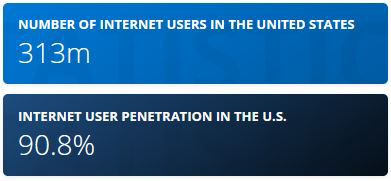
There have been some huge improvements over the past decade when it comes to broadband internet coverage, average internet speeds, and the number of internet users. The increase in average speeds has been quite noticeable, especially over the past two COVID years.
Let’s first discuss findings from the latest FCC’s Broadband Internet Deployment report. The report was published in January 2021, but the data is from 2019. The data from 2020 hasn’t been processed yet.
According to this report, 95.6% of the entire US population has access to broadband internet (at least 25/3 Mbps) – 98.8% of urban population and 82.7% of rural population. This also means that 4.4% of the population in the US (1.2% in urban areas and 17.3% in rural areas) doesn’t have access to 25/3 Mbps. It doesn’t seem a lot, but that more than 14,440,000 people.

According to the same report, 97.8% of the population in the US has access to 10/1 Mbps. That’s 99.1% of people living in urban areas and 92.5% in rural areas. So, 2.2% of people living in the US don’t have access to 10/1 Mbps or don’t have internet access at all. That gives us 7.2 million people without access to 10/1 Mbps. All these people are using the internet at slower rates or don’t have any kind of internet. So, we probably have millions of people subscribed to internet plans that include download speeds of 3 Mbps or 5 Mbps.

If you take a look at the Microsoft Airband report published in 2019, you’ll see a comparison of the FCC data from 2018 with Microsoft’s data. This report indicates that, while ‘’only’’ 21.3 million people do not have access to broadband internet (25/3), almost half of the entire US population doesn’t use the internet at broadband speeds.
We are aware that things have changed a lot over the past two years, but we can still say, with a high level of certainty, that there are millions of people that use the internet at speeds much lower than 25/3. Many of those people use the internet at speeds of 5 Mbps or even lower.
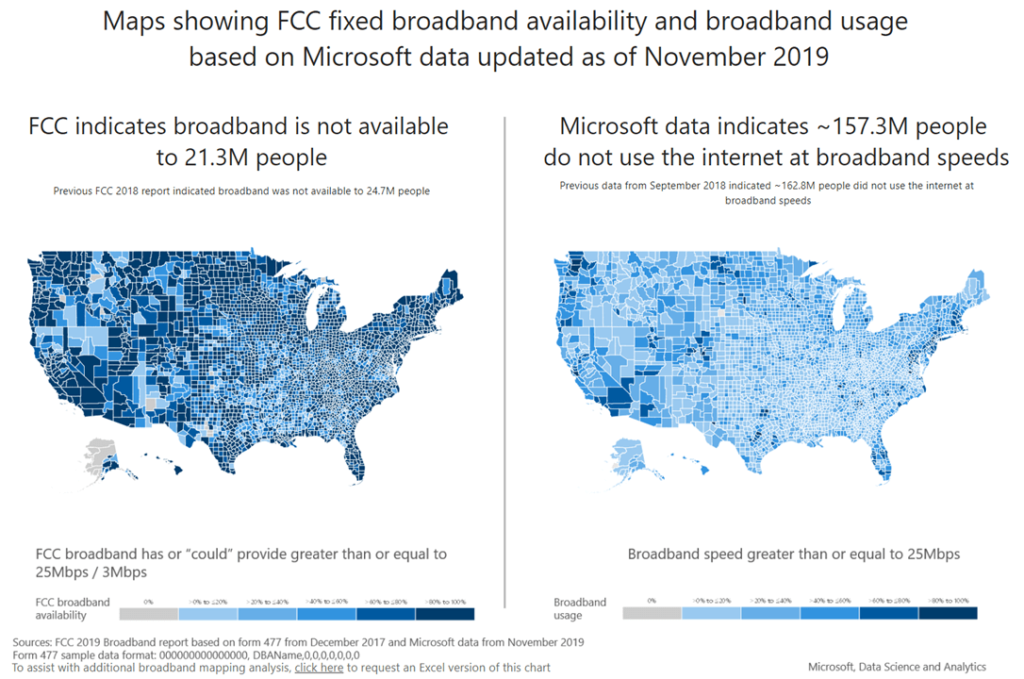
Let’s now discuss average speeds. Statista report claims that the average internet speed in US households in 2017 was only 18.75 Mbps.
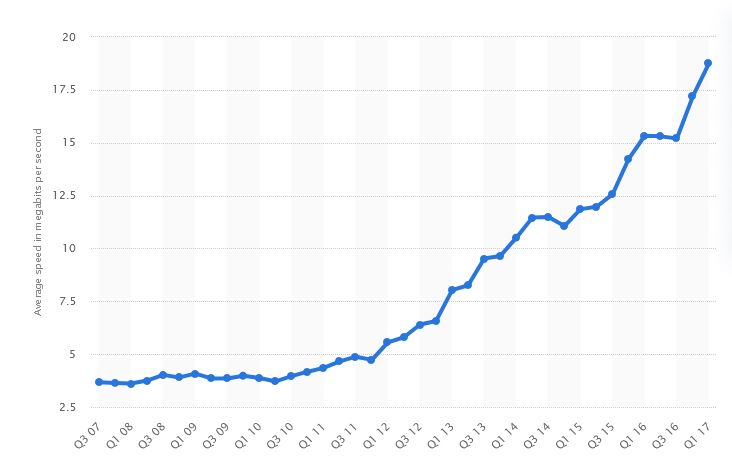
Average internet speed increase over the years 2007-2017 (source – Statista.com)
Today, we have fiber and cable internet service with speeds of up to 1 Gbps available to a huge percentage of the population. Gigabit speeds were available to almost 25% of the population in 2019, and more than 60% had access to 500 Mbps (cable or fiber). The situation today is even better. Fiber covers 43% of the population (AT&T and Verizon Fios have the greatest coverage). Cable has 90% coverage nationwide (Xfinity, Spectrum, and Cox have the best cable coverage).
The whole mess with the pandemic also had an effect on the average speed increase during the past two years. It forced us to upgrade plans since we stay at home much more. Many people also work and study from home, and that kind of lifestyle simply requires more bandwidth.
Data from different sources show different average speeds, but they all have one thing in common – compared to that Statista research, the average speeds in the US have increased a lot.
Highspeedinternet.com published a report six months ago about the average speeds in the US. According to this report, the average speed in the US is 99.3 Mbps, while the state with the highest average download speed is Rhode Island (129 Mbps). Rhode Island, by the way, also has the best fiber coverage in the US.
According to Ookla Speedtest, the average download speed in the US is even higher – 203.8 Mbps. The average upload speed is close to 74 Mbps.
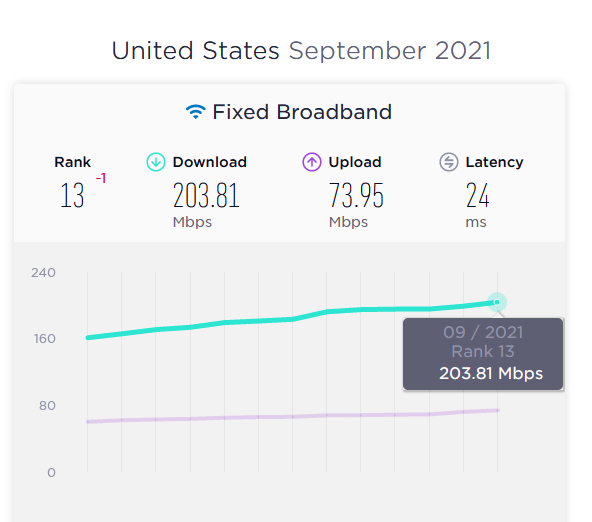
Source – Ookla Speedtest report
Median download speeds in this Ookla Speedtest report, however, don’t exceed 158 Mbps, which is much closer to the findings from the Highspeedinternet report.
Median download speeds in some states (like Wyoming, Montana, West Virginia, New Mexico, Alaska, etc.) are well below 100. In Montana, the median download speed is 54.4 Mbps.
So, even in states with the lowest average speeds, those average speeds are higher than the FCC-defined benchmark speeds (25/3 Mbps). But that still doesn’t change the fact that broadband speeds are not available to millions of citizens in the US, especially in rural areas.
Recommended Reading:
In these areas, the speeds are much lower. People are simply forced to use the internet at lower speeds, partially because the infrastructure doesn’t support higher speeds and partially because the prices of internet plans are much higher in rural areas.
Internet Prices in the US
It is not a secret that the internet in the US is much pricier than in other developed countries. Internet in rural areas of the US is probably the most expensive. That’s partially justified by the price of the infrastructure. However, there’s another reason – ISPs charge more because they can. Simple as that. In urban areas, you often have multiple providers and you get to choose, which means that ISPs have to compete. They have to offer better prices than the others. In rural areas, you often have just one provider and you can take the deal and have the internet at any cost, or you can refuse. If you refuse, you won’t have internet.
The price of internet per Mbps is much higher in rural areas than in urban areas. That’s another reason why people in rural areas pay more and have much lower average internet speeds. According to one study conducted by satelliteinternet.com, there’re rural areas with average speeds lower than 10 Mbps or even lower than 5 Mbps.
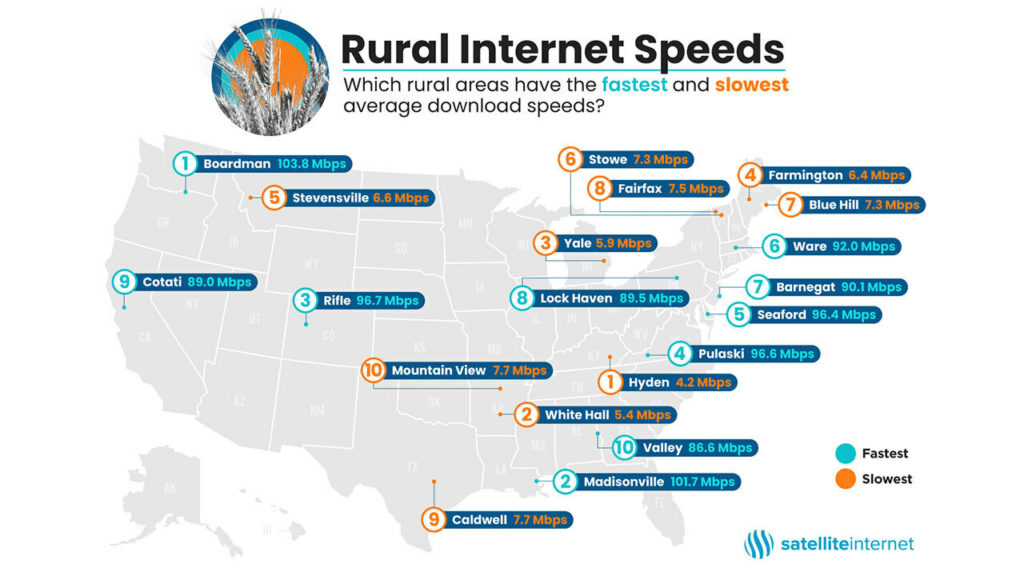
Source – satelliteinternet.com
The speeds in these areas are so low because the infrastructure is bad, but also because the prices are high. We would all like to think that lower internet speeds come at lower prices, but that is simply not the case. That can only be true if there’s some kind of competition. If there’s no competition, the prices will go wild, and the average speeds will be low.
Recommended Internet Speeds for Various Internet Activities
Even though people living in big cities are used to speeds higher than 25/3, people living in rural areas often use the internet at much lower speeds. So, what can they do with those speeds? To be more specific, what can someone do with 5 Mbps? That’s our main topic for today. Let’s see if 5 Mbps is fast enough for streaming, online gaming, video calls, etc.
FCC Recommendations
FCC defines benchmark speeds for broadband internet and also gives bandwidth recommendations for different activities.
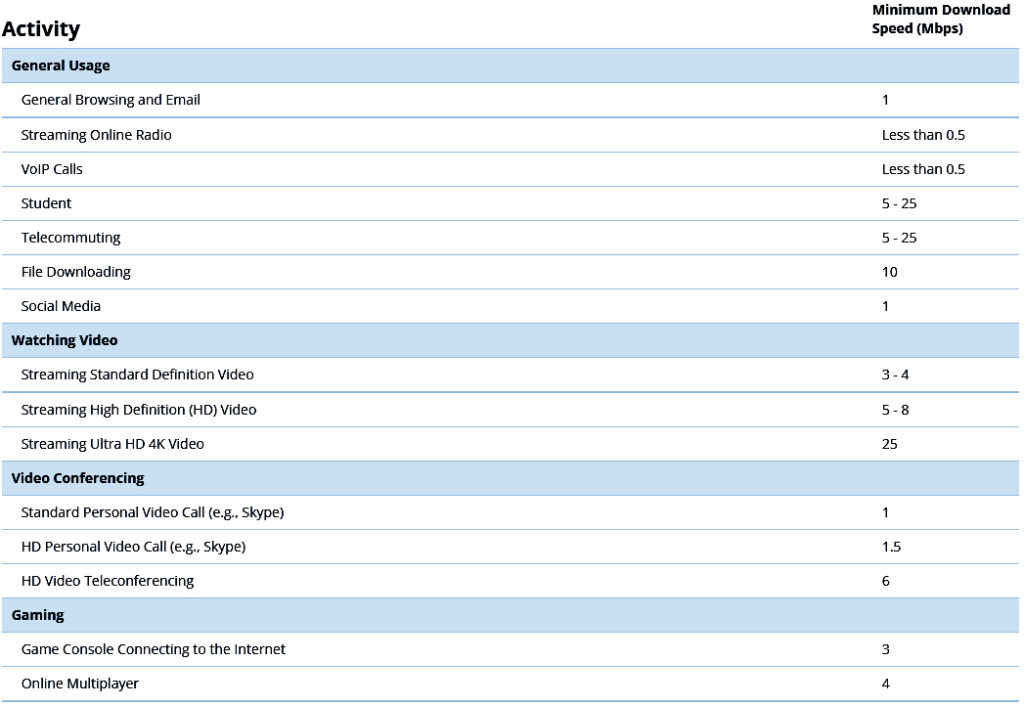
According to this guide, you can do a lot with 5 Mbps. You can stream online radio, make HD video calls, use social media, stream video content in SD (maybe even HD), and even play online games. You can’t watch 4K video content.
Video Streaming
Every streaming platform and every communication app has its own speed recommendations (sometimes even two groups – min and recommended). Let’s go through some of the most popular platforms, and try to find out what you can do with 5 Mbps.
One of the most popular movie streaming platforms, NETFLIX, can stream video content in SD, HD, and 4K/UHD. Theoretically, you can stream videos in HD (1080p) with 5 Mbps, but only if your connection is perfectly stable and if you’re not doing anything else. Even some simple activities, like email checking, may cause buffering.

YouTube has the lowest recommendations, probably because they use more aggressive compression than other streaming services, especially for HD and 4K files. With 5 Mbps download, you can watch videos in 720p without any issues. You should, theoretically, be able to watch videos in 1080p (Full HD), but only if there’re no ongoing processes in the background. While YouTube compression is aggressive and requires ”only” 20 Mbps for 4K/UHD streaming, you can’t do that with 5 Mbps.

Amazon Prime has the strongest compression and lowest requirements. For HD video, you need at least 3.5 Mbps, while a 4K video requires 15 Mbps.

Hulu also has a powerful compression for 4K videos but doesn’t compress HD videos as much. With 5 Mbps, you will only be able to watch 720p videos smoothly. 1080p videos and 4K videos require 6 and 16 Mbps.

Other popular platforms, like Apple TV+, Disney+, and HBO GO don’t stream videos in 720p. All HBO content is in HD (no 4K), while Apple TV+ and Disney+ offer HD and 4K streaming. Min speed requirement for all three services is 5 Mbps. So, you should, theoretically, be able to stream in HD with 5 Mbps, but you won’t be able to stream 4K content.



Audio Streaming
Audio streaming should not be a problem, regardless of the streaming service. All the most popular music streaming services (Spotify, Deezer, YouTube Music, Apple Music, TIDAL, etc.) have fairly low min required speeds. The same goes for online radio.
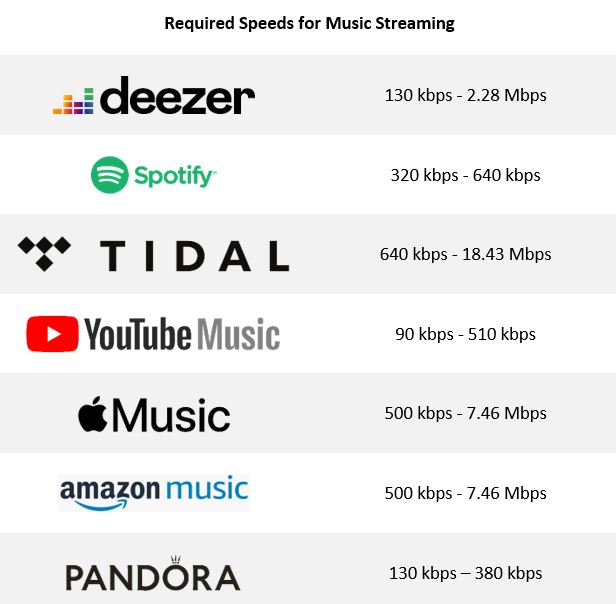
Some services (like TIDAL, Apple Music, and Amazon Music) offer Hi-Res streaming and require speeds higher than 5 Mbps. If you consider yourself an audiophile and want to listen to your music in the highest possible quality, you should be aware that 5 Mbps is not enough.
Live Streams
Live streaming is more about upload speed than about download speed. That is – if you’re creating content, then it’s about upload speeds. If you’re watching content, then it’s much more about download speeds. If your download speed is 5 Mbps, your upload speed is probably somewhere around 1 Mbps. That’s simply insufficient for creating content and live streaming. With 5/1 Mbps, you won’t be able to use YouTube Live, Facebook Live, or Twitch. You will be able to watch videos, but you won’t be able to create content.
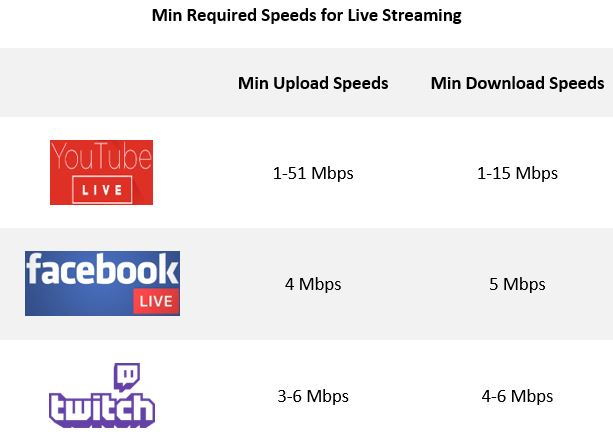
Online Gaming (Gaming Consoles, Multiplayer Online Games)
Online gaming is much trickier than video and audio streaming because it doesn’t only depend on your download and upload speeds, but also on other factors.
Theoretically, you can play online games with 5 Mbps. The FCC-recommended speeds are 3 and 4 Mbps (gaming consoles and online multiplayer games). But that doesn’t mean that your experience is going to be great.
The quality of your gaming experience will also depend on latency, packet loss, jitter. Each of these values depends on various additional factors like server proximity, router quality, game complexity, etc.
Recommended reading: Is 12 Mbps Fast?
For the best gaming experience, you need minimal latency. Latency is the response time. That’s the time needed for data to travel from your PC to your server. If the server is further away from you, the latency will be higher. Anything below 20 or 30ms is considered great. If it’s higher than 100ms, you will probably experience some problems. Anything higher than 200ms is unacceptable. There are numerous tutorials on how to reduce latency. You can find one below.
VIDEO TUTORIAL – How to reduce latency on Windows 10
Besides latency, you also have to pay attention to packet loss and jitter. If there’s too much data that has to be sent from your PC to the gaming server, and if your upload speed is too low or your router can’t handle all the data, some data packets may get lost in the process. Packet loss will make your gaming experience much worse.
Jitter is the term that describes the consistency of your latency. If your latency is consistent, even if it’s relatively high (let’s say around 50ms), you won’t have that many problems. If your latency is all over the place, you will experience stuttering, glitches, and all kinds of other problems. In other words, the game will be unplayable.
Online gaming over PS Now: 5 Mbps VS 100 Mbps
For most streaming services, the min recommended speed is higher than 5 Mbps. It’s at least 10 Mbps for Google Stadia (35 Mbps recommended), at least 5 Mbps for PlayStation Now, and at least 15 Mbps for GeForce Now.
Video Calls and Conferencing
With 5 Mbps, you should be able to make audio and video calls using popular platforms like Skype and Zoom.
With Skype, you should be able to make video calls in HQ. Video calls in HD require 1.5 Mbps upload speed, and that could be a problem since most 5 Mbps internet plans come with only 1 Mbps upload. So, you should be able to receive video calls in HD, but you won’t be able to send video in HD. You should also be able to make group calls with up to 5 people.
With Zoom, you can make 1-on-1 video calls in HQ, but not HD due to low upload speed. You should also be able to make group calls in HQ.

So, What Can You Do with 5 Mbps?
To be honest, you can’t do a lot with 5 Mbps. And you shouldn’t be doing multiple things simultaneously. Playing an online game and streaming NETFLIX (or even online radio) is not an option. Downloading something while streaming video content on YouTube is also not an option. You can stream something from Spotify and read the news at the same time, but that’s about it. You can’t do two complex and demanding online activities without experiencing issues.
5 Mbps meets the bare minimums for video streaming in HD, but only if you don’t do anything else and if the connection is perfectly stable. You can stream music using any streaming service. You can use Skype, Zoom, WhatsApp, or Viber, but you won’t be able to send video in HD.
We don’t think that 5 Mbps is good enough for activities like telecommuting or studying.
5 Mbps could be good enough for online gaming, but only if the speed is consistent and all the other parameters that affect the gaming experience are satisfying. In most cases, 5 Mbps will not be good enough for gaming.
Downloading with 5 Mbps is not that fast. It takes 8sec to download an average MP3 audio file. Downloading a single 1GB file, under ideal conditions, takes almost 30 minutes (28min 37sec). Below, you can find estimated download times for different file types and sizes.

FAQ
Q: Is 5 Mbps fast enough for Netflix?
A: 5 Mbps is good enough for smooth Netflix streaming in SD. It is the bare minimum for HD streaming – you may experience some buffering or video quality degradation issues if your internet connection is used for anything else but Netflix streaming.
Q: Is 5 Mbps fast enough for gaming?
A: It could be, at least theoretically, and at least for some games and some services. But you will also need to pay attention to latency, server proximity, packet loss, and jitter. In practice, gaming with only 5 Mbps will not be smooth. You will probably experience glitches, delay, stuttering, and other issues.
Q: Is 5 Mbps good Internet speed?
A: Not really. It’s good for some general browsing, social media, video calls, and music streaming. It’s good enough for video streaming in SD or 720p. It could, theoretically, be good enough for HD streaming. It’s not fast enough for 4K streaming and it probably isn’t good enough for online gaming.
Q: Is 5 Mbps fast enough for YouTube?
A: It depends on the video quality. 5 Mbps is fast enough for 720p and is the bare minimum for 1080p HD videos. It’s not fast enough for 4K videos.
Q: Is 5 Mbps fast enough for music streaming?
A: Yes, it is. 5 Mbps is fast enough for almost any music streaming service.
Q: Is 5 Mbps fast enough for video and conference calls?
A: 5/1 Mbps is good for one-on-one and group calls in HQ. it probably won’t be enough for HD video calls (you can receive calls in HD, but can’t send video in HD).
Q: Is 5 Mbps enough for zoom?
A: 5/1 Mbps is good enough for 1-on-1 calls and group calls in HQ. The download speed is fast enough for video calls (both 1-on-1 and group calls) in 720p and 1080p, but the upload speed is not good enough for 720p and 1080p (you can’t send video in HD).

Hey, I’m Jeremy Clifford. I hold a bachelor’s degree in information systems, and I’m a certified network specialist. I worked for several internet providers in LA, San Francisco, Sacramento, and Seattle over the past 21 years.
I worked as a customer service operator, field technician, network engineer, and network specialist. During my career in networking, I’ve come across numerous modems, gateways, routers, and other networking hardware. I’ve installed network equipment, fixed it, designed and administrated networks, etc.
Networking is my passion, and I’m eager to share everything I know with you. On this website, you can read my modem and router reviews, as well as various how-to guides designed to help you solve your network problems. I want to liberate you from the fear that most users feel when they have to deal with modem and router settings.
My favorite free-time activities are gaming, movie-watching, and cooking. I also enjoy fishing, although I’m not good at it. What I’m good at is annoying David when we are fishing together. Apparently, you’re not supposed to talk or laugh while fishing – it scares the fishes.
